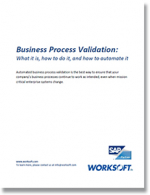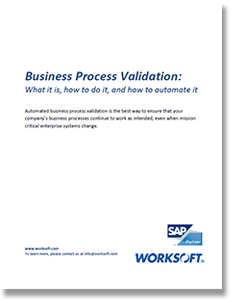Business Process Validation: What It Is, How to Do It, and How to Automate It
Automated business process validation is the best way to ensure that your company’s business processes continue to work as intended, even when mission critical enterprise systems change.
NEW TECHNOLOGIES LIKE SAP HANA® in-memory databases, mobile computing and migration to the cloud are creating huge business potential today for global enterprises.
But deploying them can bring enormous change to already complex enterprise system landscapes.
Change can have unintended consequences, and that means risk.
“Some companies have a handful of enterprise applications in use. Some have a hundred or more, including SAP® as a significant component,” says Shoeb Javed, CTO of Worksoft Inc.
“Companies have to ensure that their business processes work correctly across a much wider variety of systems than ever before. While these technologies create great opportunity for businesses, they also introduce significant risk. If a critical application fails, business processes can come to a grinding halt.”
How can IT organizations ensure that critical business processes continue to work as planned, when system changes are introduced?
SAP HANA, for example, is designed to tackle big data challenges by enabling organizations to match real-time analytics with transactional data. It will allow companies to make more strategic decisions and could fundamentally change the way they do business.
“SAP HANA represents a transformational change for companies that run SAP,” says Javed.
“HANA allows companies to use real-time data in new ways - so it will change business processes and drive additional upgrade cycles for companies looking to deploy it.”
Javed notes that many other drivers also increase the level of technology risk. This can come from mergers or splits, internal reorganizations, new regulatory or legal mandates, new software modules or updates of existing apps.
CIOs working in this increasingly complex environment are challenged to reduce the likelihood of unexpected events and project failures. They must be able to ensure that with any change to applications or infrastructure, critical business processes will continue to function. For this to happen, legacy tools and manual testing are not viable options.
Validate business processes with end-to-end automation. Lower risk. Lower expenses.
“You may be able to manually test a business process with 10 variations, but what if you have a business process that works with 10 different mobile devices and operating systems? You now have 100 tests instead of 10 tests,” says Javed. “And if the process spans 10 more enterprise systems, you’ve just multiplied the challenge a thousandfold. You have to automate business process validation just to keep up.”
With end-to-end business process validation, CIOs can identify issues before they become problems, thus reducing risk and lowering the total cost of ownership of managing the enterprise’s business applications. Automated solutions for business process validation enable companies to conduct business with reliability and without disruption, even as they reduce expenses.
What’s Related


Favorites





